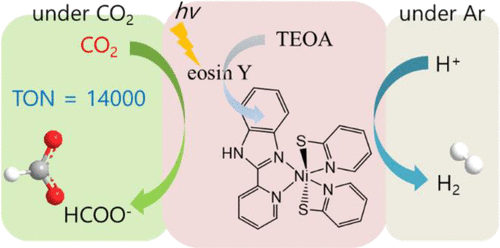当前位置:
X-MOL 学术
›
J. Am. Chem. Soc.
›
论文详情
Our official English website, www.x-mol.net, welcomes your
feedback! (Note: you will need to create a separate account there.)
Visible-Light Photocatalytic Conversion of Carbon Dioxide by Ni(II) Complexes with N4S2 Coordination: Highly Efficient and Selective Production of Formate
Journal of the American Chemical Society ( IF 14.4 ) Pub Date : 2020-10-19 , DOI: 10.1021/jacs.0c08145 Sung Eun Lee 1 , Azam Nasirian 1 , Ye Eun Kim 1 , Pegah Tavakoli Fard 1 , Youngmee Kim 1 , Byeongmoon Jeong 1 , Sung-Jin Kim 1 , Jin-Ook Baeg 2 , Jinheung Kim 1
Journal of the American Chemical Society ( IF 14.4 ) Pub Date : 2020-10-19 , DOI: 10.1021/jacs.0c08145 Sung Eun Lee 1 , Azam Nasirian 1 , Ye Eun Kim 1 , Pegah Tavakoli Fard 1 , Youngmee Kim 1 , Byeongmoon Jeong 1 , Sung-Jin Kim 1 , Jin-Ook Baeg 2 , Jinheung Kim 1
Affiliation

|
The efficient and selective light-driven conversion of carbon dioxide to formate is a scientific challenge for green chemistry and energy science, especially utilizing visible-light energy and earth-abundant catalytic materials. In this report, two mononuclear Ni(II) complexes of pyridylbenzimidazole (pbi) and pyridylbenzothiazole (pbt), such as Ni(pbt)(pyS)2 (1) and Ni(pbi)(pyS)2 (2) (pyS = pyridine-2-thiolate), were prepared and their reactivities studied. The two Ni complexes were examined for CO2 conversion using eosin Y as a photosensitizer upon visible-light irradiation in a H2O/ethanol solvent. The photoreaction of CO2 catalyzed by complexes 1 and 2 selectively affords formate with a high efficiency (14 000 turnover number) and a high catalytic selectivity of ∼99%. Undesirable proton reduction pathways were completely suppressed in the photocatalytic reactions with these sulfur-rich Ni catalysts under CO2. Hydrogen photoproduction was also studied under argon. Their kinetic isotope effects and influence of solution pH for formate and H2 production in the photocatalytic reactions are described in relation to the reaction mechanisms. These bioinspired Ni(II) catalysts with N/S ligation in relation to [NiFe]-hydrogenases are the first examples of early transition metal complexes affording such high selectivity and efficiencies, providing a future path to design solar-to-fuel processes for artificial photosynthesis.
中文翻译:

Ni(II) 配合物与 N4S2 配位对二氧化碳的可见光光催化转化:高效和选择性地生产甲酸盐
将二氧化碳高效、选择性地光驱动转化为甲酸盐是绿色化学和能源科学的科学挑战,尤其是利用可见光能量和地球上丰富的催化材料。在本报告中,吡啶基苯并咪唑 (pbi) 和吡啶基苯并噻唑 (pbt) 的两种单核 Ni(II) 配合物,例如 Ni(pbt)(pyS)2 (1) 和 Ni(pbi)(pyS)2 (2) (pyS =吡啶-2-硫醇盐),并研究了它们的反应性。使用曙红 Y 作为光敏剂,在可见光照射下,在 H2O/乙醇溶剂中检查这两种 Ni 配合物的 CO2 转化率。由配合物 1 和 2 催化的 CO2 光反应选择性地提供了高效(14 000 周转数)和约 99% 的高催化选择性的甲酸盐。在 CO2 下与这些富含硫的 Ni 催化剂的光催化反应中,不希望的质子还原途径被完全抑制。在氩气下也研究了氢光产生。它们的动力学同位素效应和溶液 pH 值对光催化反应中甲酸盐和 H2 产生的影响与反应机制有关。这些具有与 [NiFe]-氢化酶相关的 N/S 连接的仿生 Ni(II) 催化剂是早期过渡金属配合物的第一个例子,提供如此高的选择性和效率,为设计用于人工的太阳能到燃料的过程提供了未来途径。光合作用。它们的动力学同位素效应和溶液 pH 值对光催化反应中甲酸盐和 H2 产生的影响与反应机制有关。这些具有与 [NiFe]-氢化酶相关的 N/S 连接的仿生 Ni(II) 催化剂是早期过渡金属配合物的第一个例子,提供如此高的选择性和效率,为设计用于人工的太阳能到燃料的过程提供了未来途径。光合作用。它们的动力学同位素效应和溶液 pH 值对光催化反应中甲酸盐和 H2 产生的影响与反应机制有关。这些具有与 [NiFe]-氢化酶相关的 N/S 连接的仿生 Ni(II) 催化剂是早期过渡金属配合物的第一个例子,提供如此高的选择性和效率,为设计用于人工的太阳能到燃料的过程提供了未来途径。光合作用。
更新日期:2020-10-19
中文翻译:

Ni(II) 配合物与 N4S2 配位对二氧化碳的可见光光催化转化:高效和选择性地生产甲酸盐
将二氧化碳高效、选择性地光驱动转化为甲酸盐是绿色化学和能源科学的科学挑战,尤其是利用可见光能量和地球上丰富的催化材料。在本报告中,吡啶基苯并咪唑 (pbi) 和吡啶基苯并噻唑 (pbt) 的两种单核 Ni(II) 配合物,例如 Ni(pbt)(pyS)2 (1) 和 Ni(pbi)(pyS)2 (2) (pyS =吡啶-2-硫醇盐),并研究了它们的反应性。使用曙红 Y 作为光敏剂,在可见光照射下,在 H2O/乙醇溶剂中检查这两种 Ni 配合物的 CO2 转化率。由配合物 1 和 2 催化的 CO2 光反应选择性地提供了高效(14 000 周转数)和约 99% 的高催化选择性的甲酸盐。在 CO2 下与这些富含硫的 Ni 催化剂的光催化反应中,不希望的质子还原途径被完全抑制。在氩气下也研究了氢光产生。它们的动力学同位素效应和溶液 pH 值对光催化反应中甲酸盐和 H2 产生的影响与反应机制有关。这些具有与 [NiFe]-氢化酶相关的 N/S 连接的仿生 Ni(II) 催化剂是早期过渡金属配合物的第一个例子,提供如此高的选择性和效率,为设计用于人工的太阳能到燃料的过程提供了未来途径。光合作用。它们的动力学同位素效应和溶液 pH 值对光催化反应中甲酸盐和 H2 产生的影响与反应机制有关。这些具有与 [NiFe]-氢化酶相关的 N/S 连接的仿生 Ni(II) 催化剂是早期过渡金属配合物的第一个例子,提供如此高的选择性和效率,为设计用于人工的太阳能到燃料的过程提供了未来途径。光合作用。它们的动力学同位素效应和溶液 pH 值对光催化反应中甲酸盐和 H2 产生的影响与反应机制有关。这些具有与 [NiFe]-氢化酶相关的 N/S 连接的仿生 Ni(II) 催化剂是早期过渡金属配合物的第一个例子,提供如此高的选择性和效率,为设计用于人工的太阳能到燃料的过程提供了未来途径。光合作用。











































 京公网安备 11010802027423号
京公网安备 11010802027423号